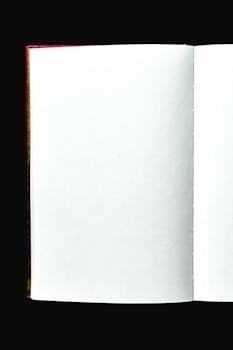useful and instructive poetry lewis carroll
Lewis Carroll’s Use of Poetry⁚ An Overview
Lewis Carroll‚ born Charles Dodgson‚ masterfully integrated poetry into his works‚ notably within Alice’s Adventures in Wonderland and Through the Looking-Glass. His poems are frequently parodies‚ subverting the didactic verse common in Victorian times. Carroll’s use of wordplay and nonsense creates both humorous and thought-provoking effects‚ while also advancing the plot and engaging with concepts of language and logic. His poetry reflects the Victorian era’s fascination with fantasy‚ and offers entertainment for both children and adults.
Carroll’s Background and Literary Style
Charles Lutwidge Dodgson‚ famously known as Lewis Carroll‚ was born in 1832 and was an English writer‚ poet‚ mathematician‚ and photographer. Growing up in a large family‚ he developed a love for reading and began writing poetry at a young age. Carroll’s background in mathematics and logic profoundly influenced his literary style‚ which is characterized by playful use of language‚ wordplay‚ and nonsensical elements. His works‚ like Alice’s Adventures in Wonderland and Through the Looking-Glass‚ are renowned for their blending of fantasy with logical puzzles and philosophical concepts. Carroll often used made-up words and phrases to create humorous and thought-provoking effects‚ subverting traditional expectations of language and storytelling. He was also fond of parody‚ taking existing didactic poems and transforming them into something new‚ often with an absurd or humorous twist. His unique approach to writing reflects a fascination with both the possibilities and absurdities of language itself. This unique style helped him to create his famous poems which became an important part of his work.
Didacticism vs. Entertainment in Carroll’s Works
Lewis Carroll’s works notably challenge the Victorian era’s emphasis on didacticism‚ the idea that literature should primarily teach moral lessons. While many children’s books of his time were heavily instructive‚ Carroll instead prioritized entertainment and whimsy. His use of poetry often serves to subvert the didactic poems that were common in Victorian society by parodying them. He transforms these serious verses into humorous and nonsensical pieces‚ offering a playful alternative to the straightforward moralizing. Carroll’s approach doesn’t entirely abandon instruction‚ but rather embeds it within imaginative storytelling and games with language. By engaging with philosophical concepts and logical puzzles within a fictional framework‚ he stimulates intellectual curiosity and critical thinking. Therefore‚ Carroll’s work represents a shift from pure didacticism to a blend of entertainment and subtle education. This allows young readers to both enjoy and learn from his writings. His style greatly contributed to the development of children’s literature.

Parody and Subversion in Carroll’s Poetry
Carroll’s poetry is characterized by its use of parody‚ where he transforms well-known poems into humorous and nonsensical versions. This technique subverts traditional Victorian didactic verse‚ challenging their serious tone and moralistic content.

Parody of Didactic Victorian Poems
Lewis Carroll’s parodies of didactic Victorian poems serve as a pivotal element in his literary works‚ most notably in Alice’s Adventures in Wonderland. He cleverly takes existing‚ often moralistic‚ poems and transforms them into comical and absurd versions. This technique is not merely for humor; it is a deliberate subversion of the era’s emphasis on instruction and moral lessons in children’s literature. Carroll’s parodies mock the seriousness and often overly simplistic nature of didactic verse‚ replacing it with whimsical nonsense. By doing this‚ he highlights the absurdity of some Victorian educational ideals‚ inviting readers to question rigid norms. The parodies often retain the structure and rhyme scheme of the original poems‚ but with nonsensical or contradictory content‚ which amplifies the humorous effect. These parodies not only entertain but also challenge the reader’s perception of what poetry should be‚ moving away from strict moralizing and toward creativity and imagination. This is an example of Carroll’s genius in subtly questioning the prevailing attitudes of his time.
Examples of Parodied Poems⁚ “You Are Old‚ Father William”
One of the most well-known examples of Lewis Carroll’s parodic technique is his reimagining of Robert Southey’s didactic poem‚ “The Old Man’s Comforts and How He Gained Them‚” into “You Are Old‚ Father William.” This poem‚ featured in Alice’s Adventures in Wonderland‚ showcases Carroll’s ability to twist the original’s moralizing tone into something utterly absurd and humorous; In Southey’s version‚ an old man is praised for his virtuous life‚ whereas in Carroll’s parody‚ Father William performs bizarre and illogical actions‚ such as standing on his head and balancing an eel on his nose. This subversion of the original didactic purpose highlights the contrast between the expected moral lesson and the nonsensical behavior. By maintaining the original poem’s structure while altering its substance‚ Carroll emphasizes the absurdity of blindly adhering to didactic norms. “You Are Old‚ Father William” serves not only as a parody but also as a vehicle for character development within the narrative‚ reinforcing Carroll’s playful engagement with Victorian literary conventions and offering a moment of pure comedic relief.

Notable Poems by Lewis Carroll
Lewis Carroll’s poems‚ often characterized by wordplay and nonsense‚ are celebrated for their unique style. “Jabberwocky‚” “The Walrus and the Carpenter‚” and “The Hunting of the Snark” stand out as prime examples of his contributions to literary nonsense‚ blending humor with narrative.
“Jabberwocky”⁚ Nonsense and Wordplay
“Jabberwocky‚” perhaps Carroll’s most iconic poem‚ is a masterful display of nonsense and wordplay. Featured in Through the Looking-Glass‚ it’s not about imparting moral lessons but rather engaging with the sheer joy of language. Carroll creates a world of invented words that‚ despite lacking clear definitions‚ convey a sense of narrative and emotion. The poem’s success lies in its sounds and rhythms‚ which allow readers to intuit meaning even when literal understanding is absent. This playful approach to language demonstrates Carroll’s genius‚ making “Jabberwocky” a timeless piece that continues to captivate readers of all ages. It highlights how language can be both a tool for communication and a source of pure artistic expression. The poem’s enduring appeal proves that meaning can be found in the absence of conventional semantics‚ enriching the literary landscape with its unique form of nonsense. This is a testament to Carroll’s ingenuity and creativity in exploring the boundaries of language.
“The Walrus and the Carpenter”⁚ Narrative and Humor
“The Walrus and the Carpenter‚” found in Through the Looking-Glass‚ showcases Carroll’s ability to blend narrative with humor. Unlike didactic poems aiming to teach a moral‚ this poem presents a story that is both engaging and absurd. The tale of the walrus and the carpenter tricking oysters is a satirical commentary on social manipulation and gullibility. The poem’s characters are memorable‚ and their actions‚ while nonsensical‚ carry a kind of dark humor. The narrative unfolds with a playful rhythm‚ drawing the reader into its whimsical world. This poem‚ while not explicitly didactic‚ prompts reflection on themes of trust and deception‚ adding a layer of meaning beyond its initial humorous appeal. Carroll’s use of vivid imagery and dialogue enhances its storytelling quality‚ making it a captivating and memorable piece of literary nonsense that continues to enchant audiences with its dark wit and playful absurdity.
“The Hunting of the Snark”⁚ Literary Nonsense
The Hunting of the Snark‚ a longer poem by Carroll‚ is a prime example of literary nonsense. It eschews traditional narrative structures and didactic purposes for a journey into the absurd. The poem follows a bizarre crew on a quest for a creature called the Snark‚ offering nonsensical characters‚ situations‚ and wordplay. Unlike poems that offer clear lessons‚ “The Hunting of the Snark” revels in its lack of clear meaning‚ inviting readers to engage with its imaginative language and imagery. The poem’s structure‚ divided into fits‚ adds to its whimsical nature. While some critics have sought deeper allegorical interpretations‚ the poem’s enduring appeal lies in its ability to evoke a sense of playful bewilderment. Carroll’s masterful use of language and rhythm creates a captivating and humorous experience‚ where the pursuit of the Snark becomes a metaphor for the absurdity of life itself. The poem stands as a testament to Carroll’s skill in creating nonsense that entertains and provokes thought.

Carroll’s Influence and Legacy
Lewis Carroll’s influence on literature is undeniable‚ his works leaving a lasting impact on children’s literature and the broader literary landscape. His innovative use of nonsense‚ wordplay‚ and parody opened new avenues for creative expression‚ moving away from the strict didacticism of his time. Carroll’s playful approach to language and storytelling has inspired countless authors and artists‚ cementing his place as a literary pioneer. His iconic characters and whimsical worlds continue to captivate readers of all ages‚ demonstrating the timeless appeal of his unique blend of humor‚ fantasy‚ and intellectual curiosity. His legacy extends beyond literature‚ influencing fields such as film‚ art‚ and even mathematics; The enduring popularity of Alice’s Adventures in Wonderland and Through the Looking-Glass‚ along with his memorable poems‚ ensures that Lewis Carroll’s contributions to the world of literature will continue to be celebrated and enjoyed for generations to come. His ability to blend the absurd with the profound continues to inspire and challenge readers.
Leave a Reply